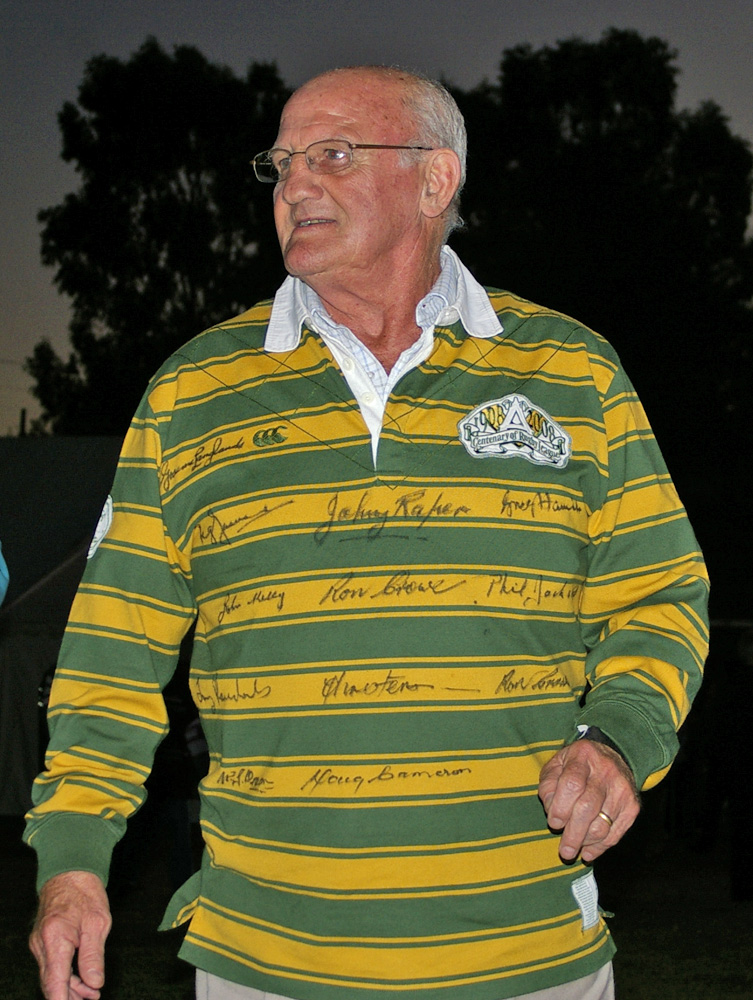- Arthur Summons
Infobox rugby league biography
playername = Arthur Summons
fullname = Arthur Summons
caption =
country =
position =
currentclub =
dateofbirth = birth date and age|1935|12|13
placeofbirth =Sydney ,
countryofbirth =Australia
height =
weight =
updated =
source =
new = yesArthur Summons (born
13 December 1935 inSydney ,Australia ) was an Australian representativerugby union andrugby league player, a dual code international. He captained theAustralian national rugby league team in 5 undefeated Tests from 1962 to 1964 and later also coached the side.choolboy representative
He was educated at the publicly funded selective
Homebush Boys High School where he captained the school's first grade rugby union side. He represented for Combined High Schools and later captained a Sydney Combined Teacher's College side.He had also played junior Rugby League with the
Mount Pritchard club.Rugby union career
He was graded with the Gordon Rugby Union Club and first represented for the Wallabies against the Springboks in 1956, then toured the British Isles with the 1957-58 side. He played in 10 Tests for the Wallabies.
Rugby league career
With a young family and needing to improve his financial position, Summons signed with Western Suburbs in 1960. He played in the 3 consecutive heart breaking Wests Grand Final losses to St George between 1961 to 1963.
He first represented Australia in Rugby league in 1961 against New Zealand appearing in six matches on tour including two Tests. He played in the two 1962 test losses against Great Britain before he was appointed Captain for the 3rd Test with
Reg Gasnier andKeith Barnes ruled out. Australia won the game 18-17 following aKen Irvine late sideline conversion of his own try.His international rugby league debut in the 1st Test against New Zealand in Auckland on 1 July 1961 saw Summons become Australia's 26th dual code rugby international, following
Rex Mossop and preceding Michael Cleary.In 1963 Summons lead Australia to wins against New Zealand, against South Africa and later that year on the Kangaroo tour of Britain for which he was appointed Captain-Coach. He missed all three tour Tests against the Lions but masterminded the Ashes victory, establishing a plan to dominate the British through the forwards. He captained Australia to victory in two Tests on the French Leg of the tour but did not represent again.
He finished his club career in Australia, playing five seasons with the Wagga Magpies and working as Secretary-Manager of the Wagga Leagues Club.
In February 2008, Summons was named in the list of Australia's "100 Greatest Players" (1908-2007) which was commissioned by the NRL and ARL to celebrate the code's centenary year in Australia. [cite news|author=Peter Cassidy |publisher="Macquarie National News"|title=Controversy reigns as NRL releases top 100 players |url=http://www.livenews.com.au/Articles/2008/02/22/Controversy_reigns_as_NRL_releases_top_100_players |accessdate=2008-02-23|date=
2008-02-23 ] [cite web|publisher="NRL & ARL"|title=Centenary of Rugby League - The Players |url=http://www.centenaryofrugbyleague.com.au/site/the-players.aspx?cat=3&list=true |accessdate=2008-02-23|date=2008-02-23 ]The Gladiators
Summons was the subject of one of the most memorable sporting photographic images ever captured in Australia. The 1963 NSW Rugby League Premiership Grand Final between long term rivals Western Suburbs and St George was played in a torrential downpour on Saturday, August 24. This, combined with the fact that the centre cricket pitch area of Sydney Cricket Ground was notoriously muddy in such conditions, ensured that the players were not only saturated but also caked in mud from head to toe. At the conclusion of the hard fought match which was won by St George, the captains of the two teams, the very tall
Norm Provan and more diminutive Summons respectively, embraced in appreciation of each other's stoic efforts. The moment was captured by a newspaper photographer,John O'Gready , and published in the following day'sSun Herald . Subsequently the image won several awards, becoming known as the "The Gladiators". This image was the inspiration for the current premiership trophy's bronze statue.ources
Whiticker, Alan (2004) "Captaining the Kangaroos", New Holland, Sydney
Footnotes
Wikimedia Foundation. 2010.
